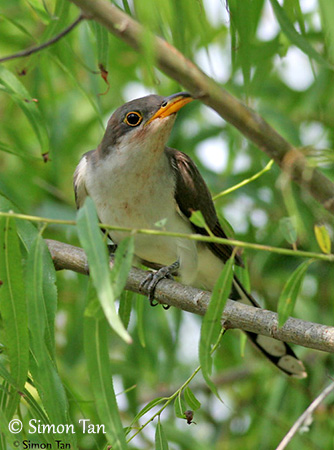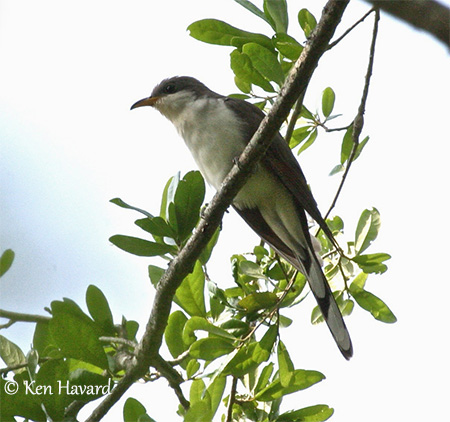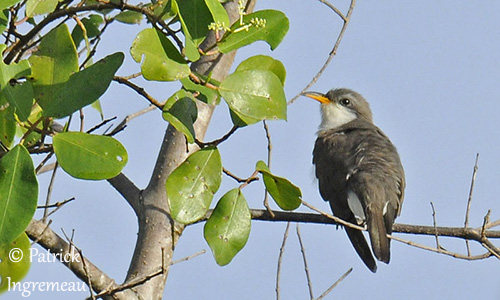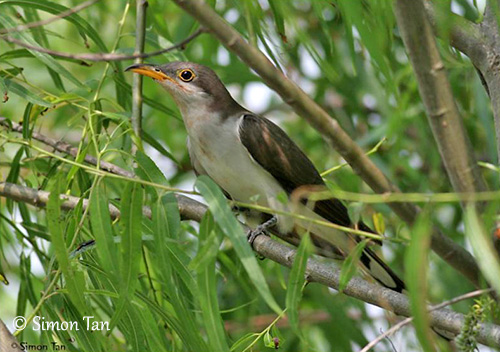
Yellow-billed Cuckoo
Coccyzus americanus
Cuculiformes Order – Cuculidae Family
INTRODUCTION:
The Yellow-billed Cuckoo is found from southern Canada to Mexico and the Caribbean during the breeding season. Following this period, it migrates to Central America and South America, S to northern Argentina.
This species frequents dense leafy groves and thickets, often near streams, rivers or lakes during summer. Outside of breeding season, it is found in tropical habitats such as forest and mangroves. It is hard to observe, but its croaking calls can be heard at a great distance.
The Yellow-billed Cuckoo feeds on hairy caterpillars and various insects, but its diet also includes lizards, frogs, bird eggs, berries and small fruits.
This species builds its own nest, although it may sometimes lay the eggs in other bird nests. But usually, both parents share the nesting duties.
The Yellow-billed Cuckoo is affected by fragmentation and degradation of the habitat caused by agricultural and residential development. The population is declining, but the Yellow-billed Cuckoo is not globally threatened at the moment.
DESCRIPTION OF THE BIRD:
Biometrics:
Length: 28-32 cm
Weight: M: 43-71 g – F: 53-78 g (they may reach up to 110 grams fat before migration, to 31 grams after over-water migration)
The Yellow-billed Cuckoo adult has uniform greyish-brown plumage on head and upperparts. On the upperwing, the outer webs of the primary flight-feathers are bright rufous, but this feature is mainly visible in flight.
The tail is long and graduated. It shows two rows of 4 to 6 large, white circles on the underside. This pattern is observed when the bird is perched or in flight. Rest of the underside of the tail is black.
The underparts are dull white.
The head is greyish-brown, but lower cheeks, chin and throat are white.
The two-tone bill is curved downwards. The upper mandible is black whereas the lower mandible is yellow or orange.
The eyes are dark brown, surrounded by bare, bright yellow eyering.
Legs and feet are slate grey with dark claws. The feet of this species are zygodactylous, with the two outer toes pointing backwards and the two inner toes pointing forwards.
Fr: Coulicou à bec jaune
Ang: Yellow-billed Cuckoo
All: Gelbschnabelkuckuck
Esp: Cuclillo Piquigualdo
Ita: Cuculo americano
Nd: Geelsnavelkoekoek
Sd: gulnäbbad regngök
Photographers:
Patrick Ingremeau
TAMANDUA
Ken Havard
My Bird Gallery & Flickr gallery 1 & Flickr gallery 2
Simon Tan
PBase Bird galleries
Text by Nicole Bouglouan
Sources:
HANDBOOK OF THE BIRDS OF THE WORLD vol 4 by Josep del Hoyo-Andrew Elliott-Jordi Sargatal - Lynx Edicions - ISBN: 8487334229
A GUIDE TO THE BIRDS OF MEXICO AND NORTHERN CENTRAL AMERICA by Steve N. G. Howell, Sophie Webb - Oxford University Press - ISBN: 0198540124
FIELD GUIDE TO THE BIRDS OF NORTH AMERICA - National Geographic Society - ISBN: 0792274512
A GUIDE TO THE BIRDS OF COLOMBIA by Steven L. Hilty and William L. Brown - Princeton University Press – ISBN 069108372X
Animal Diversity Web (University of Michigan Museum of Zoology)
Bird Web (Seattle Audubon Society)
Southern Sierra Research Station
Washington Department of Fish & Wildlife
The Online Guide to the Animals of Trinidad and Tobago
South Dakota Birds and Birding – (Terry L. Sohl)
Wikipedia, the free encyclopaedia

Male and female have similar plumage, but the female is slightly larger than the male.
The juvenile resembles adult, but the undertail pattern is less distinct, and the wing-coverts are cinnamon, duller than in adult. The eyering is dull yellow.
RANGE:
The Yellow-billed Cuckoo occurs in Nearctic and Neotropical regions.
This species breeds throughout eastern North America, southeast Canada, northern Mexico and the Greater Antilles.
It winters in South America, mainly in Peru, Bolivia and northern Argentina.
HABITAT:
The Yellow-billed Cuckoo breeds mainly in dense, deciduous habitats including woodlands with low, scrubby vegetation, abandoned farmlands and dense thickets along water, usually streams or marshes. It may be also found in overgrown orchards and dense second growth, but it is often in willow groves around marshes.
However, in the west, it is observed in trees near water such as cottonwood and willow groves in arid country.
During the winter, this species is mainly found in tropical habitats such as scrub forest and mangroves.
CALLS AND SONGS: SOUNDS BY XENO-CANTO
The Yellow-billed Cuckoo communicates by vocalizations. The species is mainly vocal during the early breeding season. It is able to produce at least six vocal sounds, depending on the situation.
The most frequent sound is the Kowlp Call consisting of 8-12 guttural, accelerating rattles which slows into a hollow clucking. It is described as “ka-ka-ka-ka-ka-kow-kow-kowlp-kowlp-kowlp-kowlp-kowlp”. It is audible at 150-200 metres and is primarily given by males.
The Knocker Call is a harsh, rattled, rapid series of “kow-kow-kow-kow-kow”. It is given by both male and female in close proximity to one another.
The Coo Call includes 5-11 soft, repeated “coo-coo-coo-coo-coo-coo-coo”. The gular area inflates and collapses with each note. The Coo Call given by the female during courtship is softer. It usually induces copulation and is followed by provision of nest material by the male.
The Cuk-cuk Call is a rapid “cuk-cuk” given by the adult when the chick is hatching, and also when returning to the nest with food.
The Mew Call is a whining call given during distraction displays when a predator threatens the nest.
The Flight Call is a series of staccato clucking phrases usually descending. It is sometimes followed by one or more “kulp” notes.
The calls are frequently given from high perch, but also when the bird is well-concealed in the foliage.
The calls of the Yellow-billed Cuckoo are audible at a great distance, and often heard on hot, humid afternoons. The bird is sometimes called “Rain Crow” as it was calling for rain!

BEHAVIOUR IN THE WILD:
The Yellow-billed Cuckoo feeds primarily on caterpillars, eating thousands of caterpillars per season, including hairy species and others. But it also takes various insects species such as cicadas, beetles, grasshoppers, katytids and crickets.
It also may eat lizards, frogs, eggs of other bird species, and berries and small fruits are also part of its diet.
It forages by clambering about through the vegetation, shrubs and trees. It gleans insects from foliage and branches. If a caterpillar or other living prey is located, it flies up and hovers to pluck it. It also catches flying insects after flying out from a perch.
The Yellow-billed Cuckoo is solitary, except during the breeding season during which they are seen in pairs. The species may appear territorial, and some interactions have been observed, but this behaviour needs more study.
They are probably monogamous, with some cases of polyandry in the western breeding range.
Prior to copulation, the female performs several times a Tail Pumping display, lowering and raising the tail several times while perched on tree branch. Immediately, the male takes a small twig from a nearby tree, and flies to land directly on female’s back. The male places the twig crosswise in the female’s bill prior to copulation during which both mates maintain hold on stick.
Following the copulation, the male flies to another perch while still holding the stick. The female remains perched, but 1-2 minutes later, she performs again the Tail Pumping display and the male returns to her to mate again with the stick in the bill. After the copulation, the male leaves the twig in the female’s bill. Some seconds later, the female drops it or may place it on a branch, as if building a nest.
In this species, the twig may act in place of food item during male-to-female offering, similar to the courtship feeding in numerous species.
Both adults share the nesting duties.
The Yellow-billed Cuckoo is fully migratory. They migrate at night, often in small groups or large flocks. They are long-distance migrants, and vagrants have been recorded in W Europe.
The Yellow-billed Cuckoo arrives in late spring on the breeding grounds, from late April-early May in the eastern populations, to mid to late May in western populations, with several variations between them in rest of the breeding range.
They leave their breeding grounds in late September-early October in the east, whereas the western birds leave 2-3 weeks earlier, between late August and mid-September.
They may winter as far as N Argentina.
The Yellow-billed Cuckoo has long, pointed wings. It flies with deep wingbeats. The flight is swift and direct. The bird flies horizontally and the flight appears laboured.

REPRODUCTION OF THIS SPECIES:
The breeding season varies depending on the range, but it occurs between May and September.
The nest of the Yellow-billed Cuckoo is built by both adults. It is a small, loose platform of twigs and stems, lined (or not) with grass, pine needles, leaves and other materials. It is placed in tree, shrub or vines, near to ground level to 30 metres above the ground, usually in tree.
The Yellow-billed Cuckoo and the Black-billed Cuckoo may lay in each other’s nests, and also in nests of other birds. In addition, more than one female may lay in a nest.
The female lays 3-4, sometimes 1-5 and even more bluish-green eggs, especially when caterpillars and insects are abundant.
Both adults incubate (but the female does most of this work), during 11-14 days. At hatching, the chicks have blackish skin with dusty-grey down. The mouth lining is reddish and several white papillae can be seen within the mouth. The feet are bluish-green.
The young fledge 8-9 days after hatching, but they are still fed by their parents until they become independent. The length of this period is unknown.
This species usually produces two broods per season, occasionally three.
PROTECTION / THREATS / STATUS:
The Yellow-billed Cuckoo is affected by degradation and fragmentation of the habitat for agriculture and residential expansion. The use of pesticides against its preferred prey items has also a negative impact.
Collisions with high towers and buildings, nest disturbance with loud traffic noise in urban habitats and climate change (El Niño) also threaten this species.
The main predators are the Aplomado Falcon, the Blue Jay and the Common Grackle. Snakes and mammals probably kill young birds too.
The size of the global population is estimated to number 9,600,000 mature individuals (2019). This population is declining.
But currently, the species is not globally threatened and the Yellow-billed Cuckoo is evaluated as Least Concern.
